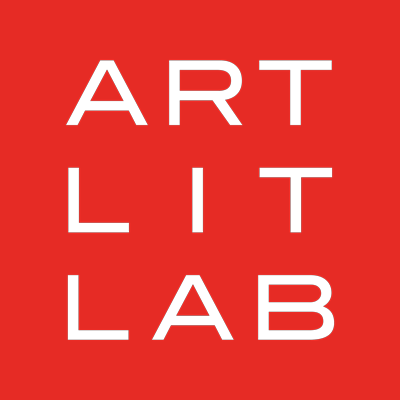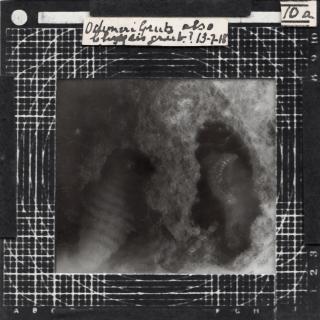Sunset isn’t when one typically thinks of viewing an art exhibit, but there isn’t much average about Emily Leach’s “Reminder (On the Cultivation of Decay),” which is on view through the windows of the Arts + Literature Laboratory from sunset to midnight through August 29.
Leach works primarily with glass and created this unique exhibit using lantern slides, which she heard about through a studio visit a few years ago with Dr. Jill Casid, who wrote “Scenes of Projection: Recasting the Enlightenment Subject.” This served as a major influencer of Leach’s exhibit.
Like so many things upended by the COVID-19 pandemic, Leach wasn’t planning this exhibit when she was accepted into the ALL’s Bridge Work: Madison program after graduating last summer with a Bachelor of Fine Arts from UW-Madison.
ALL: Can you describe the glass photographic slides viewers will see in “Reminder (On the Cultivation of Decay)”?
Emily Leach: The “glass photographic slides” in the show are called lantern slides – which is a fairly uncommon term that sounds very fantastical. Magic lanterns are an early method of projection developed during the so-called scientific revolution and Enlightenment period.
The slides in this exhibition are part of a wave of the mass-production of lantern slides during the early 20th century. At that time, lantern slides were predominantly used for educational purposes. The slides in my collection were decommissioned from universities, state departments, libraries and archives and acquired by antique dealers on eBay.
The slides are roughly between the size of a playing card and a postcard.
ALL: There are a lot of ways we could choose to comment on the current climate. What inspired you to connect the Spanish Flu of 1918 to the current coronavirus pandemic in this particular way?
EL: In March, right as the collective response to the coronavirus was coming to a head in the United States, I was at the Vermont Studio Center at the start of a month-long residency. … On Friday, March 13, the VSC residents were asked to leave due to the pandemic; we were given about 48 hours to travel home (or find alternate shelter).
I needed to recalibrate and consider how to make work that could be accessible during a period where movement and space have been restricted. … When I returned to Madison, I got a reminder notification for a watched item on eBay. When I clicked through to that particular shop, I found a huge collection of magic lantern slides. It hadn’t occurred to me that these materials would be readily available and relatively cheap. I was curious and wanted to collect a few.
Around that time, there was an opinion piece published in the NY Times by Sarah Elizabeth Lewis titled, “Where Are the Photos of People Dying of COVID?”
We’re presently at the intersection of many global crises, and this project is my effort to synthesize a few of them. I’m grateful that this show was still possible and that it provided an outlet for continuing to pursue my particular research and interests.
ALL: What types of images were you seeking?
EL: At this point, I’ve collected a wide variety of magic lantern slides. Predominantly, though, I’ve focused on collecting images of plantations, factories and landscapes in the early 20th century.
ALL: When you were creating this exhibit, was it intentional to have it viewed through windows?
EL: As the COVID-19 pandemic developed, I made the assumption that viewers would not be able to access the gallery space. … I became interested in considering how these restrictions and boundaries (after sunset, on the street, through a window) related back to the subject matter.
Making work that adheres to social distancing protocols felt essential, even if it was daunting. I really enjoyed Garver Feed Mill’s “Outside Looking In” drive-thru art exhibition, which had beautiful work by local artists and provided a great opportunity to experience art outside of the home during lockdown.
ALL: How do we benefit from viewing “Reminder” in this way?
EL: In viewing the lanterns up-close, there’s a lot of information and craft to consider. The front of the projector’s chassis is open, so viewers can actually see the original lantern slide. Because projection is such a familiar phenomenon, many viewers aren’t in the habit of carefully examining those tools of visualization.
That said, seeing the installation from the outside highlights some of the driving questions in my practice regarding access and restriction: What happens when the archive spills out, and these formerly anaesthetized images become unconsecrated, untamed and disordered? If these images are still kept within the gallery space, how does the boundary between private and public become more fragile and transparent?
The bulk of the labor spent on this project was in the design and fabrication of the magic lanterns, built specifically for this show. I’m very lucky and grateful to have worked with my partner and frequent collaborator, Ken Flanagan, on building these custom pieces of equipment.
ALL: What are you hoping to evoke from the viewer?
EL: I don’t want to prescribe thoughts and emotions to the viewer, because I am not sure what perspectives they might occupy. I’m deeply invested in making work that does not inflict or perpetuate harm while still engaging with challenging subject matter. I’m hoping to illuminate material that has been lost or marginalized, and give it space to react and change.
ALL: This exhibit is through ALL’s Bridge Work: Madison program. How has that benefited you?
EL: I’m grateful that, between funding through Bridge Work and the Dane Arts Need Grant, I had the means and institutional assistance to complete this project. Finding structure and support outside of the university system, especially in Madison, can be incredibly challenging.
As of July, the City of Madison has not allocated any new arts funding since the crisis hit. … I’m grateful for the work of members of the community who advocate for the collective power of public feedback. It is necessary to push for the budget to reflect the espoused values of the city, and to consistently challenge the status quo. This, of course, applies beyond the arts sector.
ALL: What other types of work have you created?
EL: Over the last few years, I’ve concentrated primarily on my personal family archive. I’ve been interested in commercial ancestral DNA testing and contemplating what narratives those products serve. As a Black woman, investigating my personal family history is as precious and vital as it is draining. With this project, I was interested in stepping back from the (auto)biographical.
ALL: What appeals to you about the glass medium?
EL: I’m interested in the influence of the so-called Enlightenment period and its reverberations in contemporary Western society. In my work, I consider the philosophies and strategies of optics.
I also enjoy the craft of glass-working and benefited hugely from having a portion of my artistic practice committed to a very physical routine through the UW Madison Glass Lab. Working in the hot shop helped refine my eye, my hand skills, and emphasized the power of working collaboratively and typically in partnership. Glass-working has a steep learning curve, but having a physical marker of progress from one project to the next is humbling and energizing.

